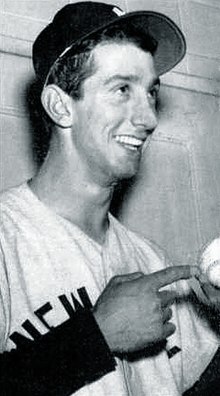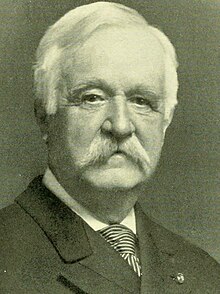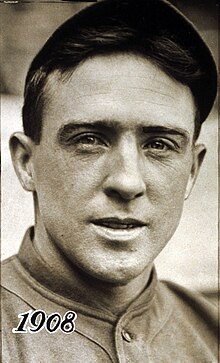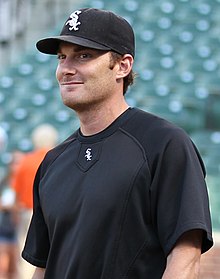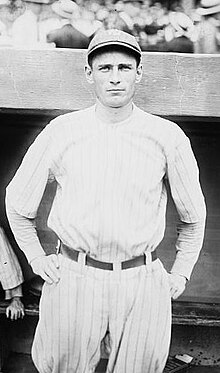Portal:Baseball
Portal maintenance status: (June 2018)
|
| Main page | Content, Categories & Topics | WikiProjects & Things you can do |
The Baseball Portal
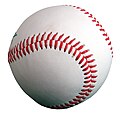
Baseball is a bat-and-ball sport played between two teams of nine players each, taking turns batting and fielding. The game occurs over the course of several plays, with each play generally beginning when a player on the fielding team, called the pitcher, throws a ball that a player on the batting team, called the batter, tries to hit with a bat. The objective of the offensive team (batting team) is to hit the ball into the field of play, away from the other team's players, allowing its players to run the bases, having them advance counter-clockwise around four bases to score what are called "runs". The objective of the defensive team (referred to as the fielding team) is to prevent batters from becoming runners, and to prevent runners' advance around the bases. A run is scored when a runner legally advances around the bases in order and touches home plate (the place where the player started as a batter).
The opposing teams switch back and forth between batting and fielding; the batting team's turn to bat is over once the fielding team records three outs. One turn batting for each team constitutes an inning. A game is usually composed of nine innings, and the team with the greater number of runs at the end of the game wins. Most games end after the ninth inning, but if scores are tied at that point, extra innings are usually played. Baseball has no game clock, though some competitions feature pace-of-play regulations such as the pitch clock to shorten game time.
Baseball evolved from older bat-and-ball games already being played in England by the mid-18th century. This game was brought by immigrants to North America, where the modern version developed. Baseball's American origins, as well as its reputation as a source of escapism during troubled points in American history such as the American Civil War and the Great Depression, have led the sport to receive the moniker of "America's Pastime"; since the late 19th century, it has been unofficially recognized as the national sport of the United States, though in modern times is considered less popular than other sports, such as American football. In addition to North America, baseball spread throughout the rest of the Americas and the Asia–Pacific in the 19th and 20th centuries, and is now considered the most popular sport in parts of Central and South America, the Caribbean, and East Asia, particularly in Japan, South Korea, and Taiwan. (Full article...)
 Featured articles - load new batch
Featured articles - load new batch
-
Image 1The 2009 World Series was the championship series of Major League Baseball's (MLB) 2009 season. As the 105th edition of the World Series, it was a best-of-seven playoff contested between the Philadelphia Phillies, champions of the National League (NL) and defending World Series champions, and the New York Yankees, champions of the American League (AL). The Yankees defeated the Phillies, 4 games to 2, winning their 27th World Series championship.
The series was played between October 28 and November 4, broadcast on Fox, and watched by an average of roughly 19 million viewers. Home field advantage for the Series went to the AL for the eighth straight year as a result of its 4–3 win in the All-Star Game. The Phillies earned their berth into the playoffs by winning the National League East. The Yankees won the American League East to earn their berth, posting the best record in the Major Leagues. The Phillies reached the World Series by defeating the Colorado Rockies in the best-of-five National League Division Series and the Los Angeles Dodgers in the best-of-seven NL Championship Series (NLCS). The Yankees defeated the Minnesota Twins in the American League Division Series and the Los Angeles Angels of Anaheim in the AL Championship Series (ALCS) to advance to their first World Series since 2003. As a result of their loss, the Phillies became the first team since the 2001 Yankees to lose the World Series after winning it the previous year. As of 2024, this is the most recent World Series to feature a defending champion. (Full article...) -
Image 2
Tyler Wayne Skaggs (July 13, 1991 – July 1, 2019) was an American left-handed professional baseball starting pitcher who played in Major League Baseball (MLB) for the Arizona Diamondbacks and Los Angeles Angels from 2012 until his death in 2019.
A native of Woodland Hills, California, and a graduate of Santa Monica High School, Skaggs was a supplemental first-round selection for the Angels in the 2009 Major League Baseball draft. He was traded to the Diamondbacks the following year as part of an exchange for pitcher Dan Haren and rose through Arizona's farm system. After two consecutive appearances at the All-Star Futures Game in 2011 and 2012, Skaggs made his major league debut on August 22, 2012, against the Miami Marlins. He remained with the Diamondbacks through the end of the season, but was optioned to the minor leagues in 2013. (Full article...) -
Image 3Rogers Hornsby tags out Babe Ruth who is caught attempting to steal second base, ending the 1926 World Series.
The 1926 World Series was the championship series of the 1926 Major League Baseball season. The 23rd edition of the Series, it pitted the National League champion St. Louis Cardinals against the American League champion New York Yankees. The Cardinals defeated the Yankees four games to three in the best-of-seven series, which took place from October 2 to 10, 1926, at Yankee Stadium and Sportsman's Park.
This was the first World Series appearance (and first National League pennant win) for the Cardinals, and would be the first of 11 World Series championships in Cardinals history. The Yankees were playing in their fourth World Series in six years after winning their first American League pennant in 1921 and their first world championship in 1923. They would play in another 36 World Series (and win 26 of those), as of the end of the 2023 season. (Full article...) -
Image 4
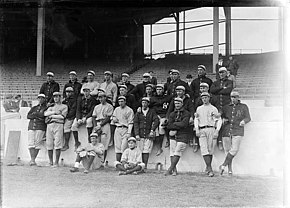
The 1913 squad, the first that went by the name "Yankees"
The history of the New York Yankees Major League Baseball (MLB) team spans more than a century. Frank J. Farrell and William Stephen Devery bought the rights to an American League (AL) club in New York City after the 1902 season. The team, which became known as the Yankees in 1913, rarely contended for the AL championship before the acquisition of outfielder Babe Ruth after the 1919 season. With Ruth in the lineup, the Yankees won their first AL title in 1921, followed by their first World Series championship in 1923. Ruth and first baseman Lou Gehrig were part of the team's Murderers' Row lineup, which led the Yankees to a then-AL record 110 wins and a Series championship in 1927 under Miller Huggins. They repeated as World Series winners in 1928, and their next title came under manager Joe McCarthy in 1932.
The Yankees won the World Series every year from 1936 to 1939 with a team that featured Gehrig and outfielder Joe DiMaggio, who recorded a record hitting streak during New York's 1941 championship season. New York set a major league record by winning five consecutive championships from 1949 to 1953, and appeared in the World Series nine times from 1955 to 1964. Mickey Mantle, Yogi Berra, and Whitey Ford were among the players fielded by the Yankees during the era. After the 1964 season, a lack of effective replacements for aging players caused the franchise to decline on the field, and the team became a money-loser for owners CBS while playing in an aging stadium. (Full article...) -
Image 5
Alfred Manuel "Billy" Martin Jr. (May 16, 1928 – December 25, 1989) was an American Major League Baseball second baseman and manager who, in addition to leading other teams, was five times the manager of the New York Yankees. First known as a scrappy infielder who made considerable contributions to the championship Yankee teams of the 1950s, he then built a reputation as a manager who would initially make bad teams good, before ultimately being fired amid dysfunction. In each of his stints with the Yankees he managed them to winning records before being fired by team owner George Steinbrenner or resigning under fire, usually amid a well-publicized scandal such as Martin's involvement in an alcohol-fueled fight.
Martin was born in a working-class section of Berkeley, California. His skill as a baseball player gave him a route out of his home town. Signed by the Pacific Coast League Oakland Oaks, Martin learned much from Casey Stengel, the man who would manage him both in Oakland and in New York, and enjoyed a close relationship with Stengel. Martin's spectacular catch of a wind-blown Jackie Robinson popup late in Game Seven of the 1952 World Series saved that series for the Yankees, and he was the hitting star of the 1953 World Series, earning the Most Valuable Player award in the Yankee victory. He missed most of two seasons, 1954 and 1955, after being drafted into the Army, and his abilities never fully returned; the Yankees traded him after a brawl at the Copacabana club in New York during the 1957 season. Martin bitterly resented being traded, and did not speak to Stengel for years, a time during which Martin completed his playing career with various teams. (Full article...) -
Image 6
Kenesaw Mountain Landis (/ˈkɛnɪsɔː ˈmaʊntɪn ˈlændɪs/; November 20, 1866 – November 25, 1944) was an American jurist who served as a United States federal judge from 1905 to 1922 and the first commissioner of baseball from 1920 until his death. He is remembered for his resolution of the Black Sox Scandal, in which he expelled eight members of the Chicago White Sox from organized baseball for conspiring to lose the 1919 World Series and repeatedly refused their reinstatement requests. His iron rule over baseball in the near quarter-century of his commissionership is generally credited with restoring public confidence in the game.
Landis was born in Millville, Ohio. Raised in Indiana, he became a lawyer, and then personal secretary to Walter Q. Gresham, the new United States Secretary of State, in 1893. He returned to private practice after Gresham died in office. (Full article...) -
Image 7

KARE (channel 11) is a television station licensed to Minneapolis, Minnesota, United States, serving as the Twin Cities area's NBC affiliate. Owned by Tegna Inc., the station maintains studios on Olson Memorial Highway (MN 55) in Golden Valley and a transmitter at the Telefarm site in Shoreview, Minnesota.
Channel 11 began broadcasting on September 1, 1953. It was originally shared by WMIN-TV in St. Paul and WTCN-TV in Minneapolis; the two stations shared an affiliation with ABC and alternated presenting local programs. In 1955, Consolidated Television and Radio bought both stations and merged them as WTCN-TV from the Minneapolis studios in the Calhoun Beach Hotel. The station presented several regionally and nationally notable children's shows in its early years as well as local cooking, news, and sports programs. Time Inc. purchased the station in 1957. Under its ownership, ABC switched its affiliation to KMSP-TV (channel 9), leaving channel 11 to become an independent station that broadcast games of the Minnesota Twins baseball team, movies, and syndicated programs. This continued under two successive owners: Chris-Craft Industries and Metromedia. By the late 1970s, WTCN was one of the nation's most financially successful independent stations. (Full article...) -
Image 8Disco Demolition Night was a Major League Baseball (MLB) promotion on Thursday, July 12, 1979, at Comiskey Park in Chicago, Illinois, that ended in a riot. At the climax of the event, a crate filled with disco records was blown up on the field between games of the twi-night doubleheader between the Chicago White Sox and the Detroit Tigers. Many had come to see the explosion rather than the games and rushed onto the field after the detonation. The playing field was so damaged by the explosion and by the rioters that the White Sox were required to forfeit the second game to the Tigers.
In the late 1970s, dance-oriented disco was the most popular music genre in the United States, particularly after being featured in hit films such as Saturday Night Fever (1977). However, disco sparked a major backlash from rock music fans—an opposition prominent enough that the White Sox, seeking to fill seats at Comiskey Park during a lackluster season, engaged Chicago shock jock and anti-disco campaigner Steve Dahl for the promotion at the July 12 doubleheader. Dahl's sponsoring radio station was WLUP (97.9 FM, now WCKL), so admission was discounted to 98 cents for attendees who turned in a disco record; between games, Dahl was to destroy the collected vinyl in an explosion. (Full article...) -
Image 9
Morris Berg (March 2, 1902 – May 29, 1972) was an American professional baseball catcher and coach in Major League Baseball who later served as a spy for the Office of Strategic Services during World War II. He played 15 seasons in the major leagues, almost entirely for four American League teams, though he was never more than an average player and was better known for being "the brainiest guy in baseball." Casey Stengel once described Berg as "the strangest man ever to play baseball."
Berg was a graduate of Princeton University and Columbia Law School, spoke several languages, and regularly read ten newspapers a day. His reputation as an intellectual was fueled by his successful appearances as a contestant on the radio quiz show Information Please, in which he answered questions about the etymology of words and names from Greek and Latin, historical events in Europe and the Far East, and ongoing international conferences. (Full article...) -
Image 10
Osborne Earl Smith (born December 26, 1954) is an American former professional baseball player. Nicknamed "The Wizard of Oz", Smith played shortstop for the San Diego Padres and St. Louis Cardinals in Major League Baseball, winning the National League Gold Glove Award for defensive play at shortstop for 13 consecutive seasons. A 15-time All-Star, Smith accumulated 2,460 hits and 580 stolen bases during his career, and won the National League Silver Slugger Award as the best hitter at shortstop in 1987. He was elected to the Baseball Hall of Fame in his first year of eligibility in 2002. He was also elected to the St. Louis Cardinals Hall of Fame in the inaugural class of 2014.
Smith was born in Mobile, Alabama; his family moved to Watts, Los Angeles, when he was six years old. While participating in childhood athletic activities, Smith possessed quick reflexes; he went on to play baseball at Locke High School in Los Angeles, then at California Polytechnic State University, San Luis Obispo. Drafted as an amateur player by the Padres, Smith made his major league debut in 1978. He quickly established himself as an outstanding fielder, and later became known for performing backflips on special occasions while taking his position at the beginning of a game. Smith won his first Gold Glove Award in 1980 and made his first All-Star Game appearance in 1981. (Full article...) -
Image 11
Morgan Gardner Bulkeley (December 26, 1837 – November 6, 1922) was an American politician of the Republican Party, businessman, and insurance executive. In 1876, he served as the first president of baseball's National League and, because of that, was inducted into the National Baseball Hall of Fame in 1937, a choice that remains controversial, since his time as a baseball executive was short.
Bulkeley was born in East Haddam, Connecticut. His father was Judge Eliphalet Adams Bulkeley, a prominent local lawyer and businessman, who became the first president of the Aetna Life Insurance Company. The family moved to Hartford, where Morgan Bulkeley was educated, before he took a job in the city of Brooklyn, New York. He served briefly in the American Civil War, where he saw no combat. When his father died in 1872, he moved back to Hartford and became a bank president and a board member of Aetna, becoming its president in 1879, a post he held the rest of his life. (Full article...) -
Image 12

James Robert "Loafer" McAleer (July 10, 1864 – April 29, 1931) was an American center fielder, manager, and stockholder in Major League Baseball who assisted in establishing the American League. He spent most of his 13-season playing career with the Cleveland Spiders, and went on to manage the Cleveland Blues, St. Louis Browns, and Washington Senators. Shortly before his retirement, he became a major shareholder in the Boston Red Sox. His career ended abruptly. During his brief tenure as co-owner of the Red Sox, McAleer quarreled with longtime friend and colleague Ban Johnson, president of the American League. In the wake of this disagreement, he sold off his shares in the Red Sox and broke off his relationship with Major League Baseball.
McAleer's rift with Johnson, along with his sudden retirement, damaged his professional reputation, and he received little recognition for his contributions to baseball. Today, he is most often remembered for initiating the customary request that the President of the United States throw out the first ball of the season. (Full article...) -
Image 13
Charles Dillon "Casey" Stengel (/ˈstɛŋɡəl/; July 30, 1890 – September 29, 1975) was an American Major League Baseball right fielder and manager, best known as the manager of the championship New York Yankees of the 1950s and later, the expansion New York Mets. Nicknamed "the Ol' Perfessor", he was elected to the Baseball Hall of Fame in 1966.
Stengel was born in Kansas City, Missouri, in 1890. In 1910, he began a professional baseball career that would span over half a century. After almost three seasons in the minor leagues, Stengel reached the major leagues late in 1912, as an outfielder, for the Brooklyn Dodgers. His six seasons there saw some success, among them playing for Brooklyn's 1916 National League championship team, but he also developed a reputation as a clown. After repeated clashes over pay with the Dodgers owner, Charlie Ebbets, Stengel was traded to the Pittsburgh Pirates in 1918; however, he enlisted in the Navy that summer, for the remainder of World War I. After returning to baseball, he continued his pay disputes, resulting in trades to the Philadelphia Phillies (in 1919) and to the New York Giants (in 1921). There, he learned much about baseball from the manager, John McGraw, and had some of the glorious moments in his career, such as hitting an inside-the-park home run in Game 1 of the 1923 World Series to defeat the Yankees. His major league playing career ended with the Boston Braves in 1925, but he then began a career as a manager. (Full article...) -
Image 14Los Angeles Angels center fielder Mike Trout hits a home run on a pitch from New York Mets pitcher Tommy Milone on May 21, 2017.
Baseball is a bat-and-ball sport played between two teams of nine players each, taking turns batting and fielding. The game occurs over the course of several plays, with each play generally beginning when a player on the fielding team, called the pitcher, throws a ball that a player on the batting team, called the batter, tries to hit with a bat. The objective of the offensive team (batting team) is to hit the ball into the field of play, away from the other team's players, allowing its players to run the bases, having them advance counter-clockwise around four bases to score what are called "runs". The objective of the defensive team (referred to as the fielding team) is to prevent batters from becoming runners, and to prevent runners' advance around the bases. A run is scored when a runner legally advances around the bases in order and touches home plate (the place where the player started as a batter).
The initial objective of the batting team is to have a player reach first base safely; this generally occurs either when the batter hits the ball and reaches first base before an opponent retrieves the ball and touches the base, or when the pitcher persists in throwing the ball out of the batter's reach. Players on the batting team who reach first base without being called "out" can attempt to advance to subsequent bases as a runner, either immediately or during teammates' turns batting. The fielding team tries to prevent runs by using the ball to get batters or runners "out", which forces them out of the field of play. The pitcher can get the batter out by throwing three pitches which result in strikes, while fielders can get the batter out by catching a batted ball before it touches the ground, and can get a runner out by tagging them with the ball while the runner is not touching a base. (Full article...) -
Image 15

WSNS-TV (channel 44) is a television station in Chicago, Illinois, United States, serving as the local outlet for the Spanish-language network Telemundo. It is owned and operated by NBCUniversal's Telemundo Station Group alongside NBC outlet WMAQ-TV (channel 5). The two stations share studios at the NBC Tower on North Columbus Drive in the city's Streeterville neighborhood and broadcast from the same transmitter atop the Willis Tower in the Chicago Loop.
WSNS-TV began broadcasting in 1970. Originally specializing in the automated display of news headlines, it evolved into Chicago's third full-fledged independent station, carrying movies, local sports, and other specialty programming. This continued until 1980, when WSNS became the Chicago-area station for ON TV, an over-the-air subscription television (STV) service owned by Oak Industries, which took a minority ownership stake in the station. While ON TV was successful in Chicago and the subscription system became the second-largest in the country by total subscribers, the rise of cable television precipitated the end of the business in 1985, with WSNS-TV as the last ON TV station standing. (Full article...)
General images - load new batch
-
Image 1An Afghan girl playing baseball in August 2002 (from Baseball)
-
Image 2Pitchers are generally substituted during mound visits (team gatherings at the pitcher's mound). (from Baseball rules)
-
Image 3Baseball games sometimes end in a walk-off home run, with the batting team usually gathering at home plate to celebrate the scoring of the winning run(s). (from Baseball rules)
-
Image 4The American Tobacco Company's line of baseball cards featured shortstop Honus Wagner of the Pittsburgh Pirates from 1909 to 1911. In 2007, the card shown here sold for $2.8 million. (from Baseball)
-
Image 7Sadaharu Oh managing the Japan national team in the 2006 World Baseball Classic. Playing for the Central League's Yomiuri Giants (1959–80), Oh set the professional world record for home runs. (from Baseball)
-
Image 8A New York Yankees batter (Andruw Jones) and a Boston Red Sox catcher at Fenway Park (from Baseball)
-
Image 9Diagram of a baseball field Diamond may refer to the square area defined by the four bases or to the entire playing field. The dimensions given are for professional and professional-style games. Children often play on smaller fields. (from Baseball)
-
Image 10In May 2010, the Philadelphia Phillies' Roy Halladay pitched the 20th major league perfect game. That October, he pitched only the second no-hitter in MLB postseason history. (from History of baseball)
-
Image 11Pick-off attempt on runner (in red) at first base (from Baseball rules)
-
Image 13The standard fielding positions (from Baseball rules)
-
Image 14The typical motion of a right-handed pitcher (from Baseball rules)
-
Image 16Sadaharu Oh managing the Japan national team in the 2006 World Baseball Classic. Playing for the Central League's Yomiuri Giants (1959–80), Oh set the professional world record for home runs with 868. (from History of baseball)
-
Image 17Jackie Robinson in 1945, with the era's Kansas City Royals, a barnstorming squad associated with the Negro American League's Kansas City Monarchs (from Baseball)
-
Image 182013 World Baseball Classic championship match between the Dominican Republic and Puerto Rico, March 20, 2013 (from Baseball)
-
Image 19A well-worn baseball (from Baseball)
-
Image 20Alexander Cartwright, father of modern baseball (from History of baseball)
-
Image 21A game from the Cantigas de Santa Maria, c. 1280, involving tossing a ball, hitting it with a stick and competing with others to catch it (from History of baseball)
-
Image 22A first baseman receives a pickoff throw, as the runner dives back to first base. (from Baseball)
-
Image 25Rickey Henderson—the major leagues' all-time leader in runs and stolen bases—stealing third base in a 1988 game (from Baseball)
-
Image 27Fenway Park, home of the Boston Red Sox. The Green Monster is visible beyond the playing field on the left. (from Baseball)
-
Image 28The NL champion New York Giants baseball team, 1913. Fred Merkle, sixth in line, had committed a baserunning gaffe in a crucial 1908 game that became famous as Merkle's Boner. (from History of baseball)
-
Image 29Cover of Official Base Ball Rules, 1921 edition, used by the American League and National League (from Baseball rules)
-
Image 30Baserunners generally stand a short distance away from their base between pitches, preparing themselves to either go back or steal the next base. (from Baseball rules)
-
Image 31Cy Young—the holder of many major league career marks, including wins and innings pitched, as well as losses—in 1908. MLB's annual awards for the best pitcher in each league are named for Young. (from Baseball)
-
Image 32A pitcher handing off the ball after being taken out of the game during a mound meeting. (from Baseball)
-
Image 34Japanese-Americans spectating a World War II-era game while in an internment camp. America's ties to immigrants and to Japan have been deeply shaped by a shared baseball heritage. (from History of baseball)
-
Image 35Defensive positions on a baseball field, with abbreviations and scorekeeper's position numbers (not uniform numbers) (from Baseball)
-
Image 36The strike zone determines the result of most pitches, and varies in vertical length for each batter. (from Baseball)
-
Image 37A batter follows through after swinging at a pitched ball. (from Baseball rules)
-
Image 38The strike zone, which determines the outcome of most pitches, varies in vertical length depending on the batter's typical height while swinging. (from Baseball rules)
-
Image 39A runner sliding into home plate and scoring. (from Baseball)
-
Image 401906 World Series, infielders playing "in" for the expected bunt and the possible play at the plate with the bases loaded (from Baseball rules)
-
Image 41Pesäpallo, a Finnish variation of baseball, was invented by Lauri "Tahko" Pihkala in the 1920s, and after that, it has changed with the times and grown in popularity. Picture of Pesäpallo match in 1958 in Jyväskylä, Finland. (from Baseball)
-
Image 42By the 1860s Civil War, baseball (bottom) had overtaken its fellow bat-and-ball sport cricket (top) in popularity within the United States. (from History of baseball)
-
Image 43Jackie Robinson in 1945, with the era's Kansas City Royals, a barnstorming squad associated with the Negro American League's Kansas City Monarchs (from History of baseball)
-
Image 44Two players on the baseball team of Tokyo, Japan's Waseda University in 1921 (from Baseball)
 Good articles - load new batch
Good articles - load new batch
-
Image 1
Joseph Bert Tinker (July 27, 1880 – July 27, 1948) was an American professional baseball player and manager. He played from 1902 through 1916 for the Chicago Cubs and Cincinnati Reds of Major League Baseball (MLB) and the Chicago Whales of the Federal League.
Born in Muscotah, Kansas, Tinker began playing semi-professional baseball in Kansas in the late 19th century, first in Kansas City, then in Parsons. He began his professional career in 1900 in minor league baseball, initially in Denver then with Portland in the Northwestern League. He made his MLB debut with the Cubs in 1902. Tinker was a member of the Chicago Cubs dynasty that won four pennants and two World Series championships between 1906 and 1910. After playing one season with Cincinnati in 1913, he became one of the first stars to jump to the upstart Federal League in 1914. After leading the Whales to the pennant in 1915, he returned to the Cubs as their player-manager in 1916, his final season in MLB. (Full article...) -
Image 2
Javier Alfonso López Palmer (born July 11, 1977) is a Puerto Rican former professional baseball pitcher. He pitched in Major League Baseball (MLB) for the Colorado Rockies (2003–05), Arizona Diamondbacks (2005), Boston Red Sox (2006–09), Pittsburgh Pirates (2010), and San Francisco Giants (2010–16). He was a left-handed specialist known for his sidearm delivery. He is currently a member of the Giants broadcast team, working alongside Dave Flemming as color commentator for their away games.
López attended the University of Virginia, earning a degree in psychology despite leaving early to begin his baseball career. In 1997, he played collegiate summer baseball with the Falmouth Commodores of the Cape Cod Baseball League. He was selected by the Arizona Diamondbacks in the fourth round of the 1998 Major League Baseball draft. He began his career as a starting pitcher but struggled, and was converted into a sidearm (or submarine) reliever while still in the Diamondbacks' organization. Before the 2003 season, he was selected by the Boston Red Sox in the Rule 5 draft, but was traded to the Colorado Rockies during spring training. He spent all of 2003 on Colorado's roster, nearly tying the franchise record for most consecutive batters retired and finishing third among major league rookies in games pitched. He struggled the next two seasons, getting claimed off waivers and later sent to the minors by Arizona in 2005. In 2006, he signed with the Chicago White Sox but failed to make the team and spent the first part of the season in the minors before getting traded to Boston during the year. (Full article...) -
Image 3

William Mitchell Steele (October 5, 1885 – October 19, 1949) was an American pitcher in Major League Baseball (MLB). He pitched from 1910 to 1914 with the St. Louis Cardinals and Brooklyn Robins. Nicknamed "Big Bill", at 5 feet 11 inches (1.80 m), he was one of the larger players of his era. His main pitch was a spitball.
Steele grew up in Milford, Pennsylvania. He began pitching at the professional level in 1909, and after winning 25 games for the Altoona Rams in 1910, he was signed by the Cardinals. Steele appeared in nine games with the team that year, then pitched a career-high 287+1⁄3 innings in 1911. He led the National League (NL) with 19 losses while posting a 3.73 earned run average (ERA). In 1912, Steele posted the worst ERA (4.69) among pitchers with enough innings to qualify for the MLB ERA title. He claimed in 1913 that he had purposefully not been trying as hard as he could have in 1912, and this impaired his relationship with the front office. Bothered by rheumatism the next couple of seasons, Steele found himself used mainly as a mopup reliever by 1914. Sold to the Robins later that year, he finished his MLB career with eight appearances in a Brooklyn uniform. Steele then played minor league baseball for a couple more seasons. A few years after he retired, he and his family moved to the St. Louis area, where he worked as a mechanic for Swift and Company and later as a maintenance man at an A&P warehouse. He was killed on October 19, 1949, when a streetcar ran into him. (Full article...) -
Image 4

Roger Philip Bresnahan (June 11, 1879 – December 4, 1944), nicknamed "the Duke of Tralee", was an American player and manager in Major League Baseball (MLB). As a player, Bresnahan competed in MLB for the Washington Senators (1897), Chicago Orphans (1900), Baltimore Orioles (1901–02), New York Giants (1902–1908), St. Louis Cardinals (1909–1912) and Chicago Cubs (1913–1915). Bresnahan also managed the Cardinals (1909–1912) and Cubs (1915). He was a member of the 1905 World Series champions.
Bresnahan began his MLB career as a pitcher. He also served as an outfielder, before becoming a regular catcher. For his MLB career, Bresnahan had a .279 batting average in 4,480 at bats and a 328–432 managerial win–loss record. Bresnahan popularized the use of protective equipment in baseball by introducing shin guards, to be worn by catchers, in 1907. He also developed the first batting helmet. (Full article...) -
Image 5
Gerald Donald Kindall (May 27, 1935 – December 24, 2017) was an American professional baseball player and college baseball player and coach. He was primarily a second baseman in Major League Baseball (MLB) who appeared in 742 games played over nine seasons for the Chicago Cubs (1956–58, 1960–61), Cleveland Indians (1962–64), and Minnesota Twins (1964–65). After his playing career, he became the head baseball coach of the University of Arizona Wildcats, winning 860 games and three College World Series (CWS) championships over 24 seasons (1973–1996). Kindall batted and threw right-handed and was listed as 6 feet 2 inches (1.88 m) tall and 175 pounds (79 kg).
Kindall was born in St. Paul, Minnesota, and graduated from Washington High School before attending the University of Minnesota. In 1956, as a student-athlete at Minnesota, his Golden Gophers won the NCAA Division I baseball championship. Twenty years later, Kindall coached the Arizona Wildcats to a CWS victory, becoming the first person to win CWS titles both as a player and as a head coach. He is also the first batter to hit for the cycle in the history of the CWS, along with being the only person to do so until Christian Moore did so in 2024. Kindall was elected to the College Baseball Hall of Fame in 2007. (Full article...) -
Image 6
Cindy Lou McCain (née Hensley; born May 20, 1954) is an American diplomat, businesswoman, and humanitarian who is the executive director of the World Food Programme. McCain previously served as U.S. Ambassador to the United Nations Agencies for Food and Agriculture from 2021 to 2023. She is the widow of U.S. Senator John McCain from Arizona, who was the 2008 Republican presidential nominee.
McCain was born and raised in Phoenix, Arizona, and is a daughter of wealthy beer distributor Jim Hensley. After receiving bachelor's and master's degrees from the University of Southern California, she became a special education teacher. She married John McCain in 1980, and the couple moved to Arizona in 1981, where her husband was elected to the United States Congress the following year and reelected five more times. The couple had three children together, in addition to adopting another. From 1988 to 1995, she founded and operated a nonprofit organization, the American Voluntary Medical Team, which organized trips by medical personnel to disaster-stricken or war-torn third-world areas. (Full article...) -
Image 7
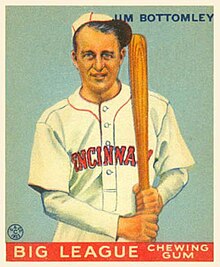
James Leroy Bottomley (April 23, 1900 – December 11, 1959) was an American professional baseball player, scout and manager. He played in Major League Baseball as a first baseman from 1922 to 1937, most prominently as a member of the St. Louis Cardinals where he helped lead the team to four National League pennants and two World Series titles.
Born in Oglesby, Illinois, Bottomley grew up in Nokomis, Illinois. He dropped out of high school at the age of 16 to raise money for his family. While he was playing semi-professional baseball, the Cardinals scouted and signed Bottomley before the 1920 season. He became an integral member of the Cardinals batting order, driving in 100 or more runs batted in between 1924 and 1929 as the team's cleanup hitter. In 1924, he established a major league record for driving in 12 runs in a nine inning game. (Full article...) -
Image 8
Timothy Leroy Lincecum (/ˈlɪnsəkʌm/ LIN-sə-kum; born June 15, 1984), nicknamed "the Freak", is an American former professional baseball pitcher who played ten seasons in Major League Baseball (MLB), primarily for the San Francisco Giants. A two-time Cy Young Award winner, Lincecum helped the Giants win three World Series championships from 2010 through 2014.
A graduate of Liberty Senior High School in Renton, Washington, Lincecum played college baseball at the University of Washington where he won the 2006 Golden Spikes Award. That year, Lincecum became the first Washington Husky to be selected in the first round of an MLB Draft when the San Francisco Giants selected him tenth overall. (Full article...) -
Image 9
Aaron Ryan Rowand (born August 29, 1977) is an American former professional baseball center fielder in Major League Baseball. He played for the Chicago White Sox, Philadelphia Phillies, and the San Francisco Giants and won two World Series championships. During his playing days, Rowand stood 6 feet (1.8 m) tall and weighed 210 pounds (95 kg). He batted and threw right-handed.
Born in Portland, Oregon, Rowand was raised in Glendora, California. He attended California State University, Fullerton, where he was named an All-American in 1998. Drafted by the White Sox in the first round that year, he debuted with the team in 2001. By 2004, he was the team's everyday center fielder. He hit 24 home runs in 2004, batting .310. In 2005, he was part of the White Sox team that defeated the Houston Astros in the World Series for their first championship since 1917. After the season, he was traded to the Phillies as part of a trade that sent Jim Thome to Chicago. During his time with Chicago, Rowand was extremely popular with White Sox fans, owing to his all-out style of play. (Full article...) -
Image 10Pounders pitching for the Omaha Storm Chasers in 2016
Brooks Casey Pounders (born September 26, 1990) is an American former professional baseball pitcher. He attended Temecula Valley High School in Temecula, California, and chose not to attend college after he was drafted by the Pittsburgh Pirates in 2009. After playing in the minor leagues for the Pirates, he was traded to the Kansas City Royals after the 2011 season. While in the Royals' minor league system, Pounders threw a no-hitter for the Northwest Arkansas Naturals in 2013. He made his major league debut with the Royals in 2016, and he was traded to the Los Angeles Angels after the season ended.
Pounders spent 2017 alternating between the Angels' major league club and the minor leagues, before becoming a free agent at the end of the season. Before the 2018 season, Pounders signed a contract with the Colorado Rockies and played for both the Rockies and their Triple A-level affiliate. Again a free agent after the 2018 season, Pounders signed with the Cleveland Indians, but never played a major league game with the team. On June 15, he was traded to the New York Mets and immediately became part of the Mets' major league team. He played briefly with the team before being sent back down to the minor league Syracuse Mets. Pounders was part of the United States national baseball team in the 2015 and 2019 WBSC Premier12 tournaments. (Full article...) -
Image 11The 1998 National League Wild Card tie-breaker game was a one-game extension to Major League Baseball's (MLB) 1998 regular season, played between the Chicago Cubs and San Francisco Giants to determine the winner of the National League (NL) wild card. The game took place at Wrigley Field in Chicago, on September 28, 1998. The Cubs won the game 5–3, holding the Giants scoreless for the majority of the game until the Giants threatened heavily in the ninth inning and scored all three runs. As a result of the game, the Cubs qualified for the postseason and the Giants did not.
The game was necessary after both teams finished the season with identical win–loss records of 89–73. The Cubs won a coin flip late in the season which, by rule at the time, awarded them home field for the game. This victory advanced the Cubs to the 1998 NL Division Series (NLDS) where they were swept by the Atlanta Braves, ending the Cubs' season. Michael Jordan, a popular Chicago sportsman then ending his career with the Chicago Bulls, threw the game's ceremonial first pitch. In baseball statistics, the tie-breaker counted as the 163rd regular season game for both teams, with all events in the game added to regular season statistics. (Full article...) -
Image 12The 2013 American League Wild Card tie-breaker game was a one-game extension to Major League Baseball's (MLB) 2013 regular season, played between the Texas Rangers and Tampa Bay Rays to determine the second participant in the 2013 American League (AL) Wild Card Game. It was played at the Globe Life Park in Arlington on September 30, 2013. The Rays defeated the Rangers, 5–2, and advanced to the AL Wild Card Game against the Cleveland Indians at Progressive Field, which they won 4–0; the Rangers failed to qualify for the postseason.
The tie-breaker game was necessary after both teams finished the season with win–loss records of 91–71 and thus tied for the second Wild Card position in the AL. The Rangers were awarded home field for the game, as they won the regular season series against the Rays, 4–3. The game was televised on TBS. It was the fourth tie-breaker in MLB history for a Wild Card spot, although it was the first when MLB used the format of two Wild Card teams playing in a Wild Card Game from 2012 to 2021. The tie-breaker counted as the 163rd regular season game for both teams, with all events in the game added to regular season statistics. (Full article...) -
Image 13
Philip Humber of the Chicago White Sox pitched a perfect game against the Seattle Mariners by retiring all 27 batters he faced on April 21, 2012, as the White Sox defeated the Mariners 4–0. It was the 21st perfect game in Major League Baseball (MLB) history and the third by a member of the White Sox, and remains the earliest calendar date for a perfect game in MLB history. It was Humber's first career complete game, although he had come close to achieving no-hitters on several occasions at several levels of organized baseball. The game was played in Seattle and broadcast regionally by Fox Sports in the two teams' metropolitan areas.
Humber, a top pitching prospect from a Texas high school, attended Rice University, where he had a successful career. A high draft pick by the New York Mets, he debuted in MLB for the Mets before headlining a group of four prospects traded to the Minnesota Twins for Johan Santana. After two ineffective seasons with the Twins, Humber pitched a season for the Kansas City Royals. Acquired on waivers by the Chicago White Sox in 2011, Humber had his first successful season in an MLB starting rotation. The perfect game, Humber's 30th career start and his 2nd of the 2012 season, totaled 96 pitches. (Full article...) -
Image 14Burton F. Gustafson (November 30, 1925 – October 22, 2022) was an American athlete and sports coach. After attending Northern Michigan University (NMU) where he was a three-sport star, he coached several high school football, basketball, and track and field teams. He then returned to NMU where he served from 1956 to 1961 as a coach in four sports. He later was an assistant coach for the Wyoming Cowboys and coach and administrator for the Green Bay Packers. (Full article...)
-
Image 15
Walter Clement "Wally" Pipp Sr. (February 17, 1893 – January 11, 1965) was an American professional baseball player. A first baseman, Pipp played in Major League Baseball (MLB) for the Detroit Tigers, New York Yankees, and Cincinnati Reds between 1913 and 1928.
After appearing in 12 games for the Tigers in 1913 and playing in the minor leagues in 1914, he was purchased by the Yankees before the 1915 season. They made him their starting first baseman. He and Home Run Baker led an improved Yankee lineup that led the league in home runs. He led the American League in home runs in 1916 and 1917. With Babe Ruth, Bob Meusel, Joe Dugan, and Waite Hoyt, the Yankees won three consecutive American League pennants from 1921 through 1923, and won the 1923 World Series. In 1925, he lost his starting role to Lou Gehrig, after which he finished his major league career with Cincinnati. (Full article...)
Did you know (auto-generated) - load new batch

- ... that Genevieve Beacom became the first woman to pitch in the Australian Baseball League when she made her debut for the Melbourne Aces in 2022?
- ... that Margaret Donahue was the first female executive in Major League Baseball?
- ... that baseball player Joey Marciano is a cousin of world heavyweight champion Rocky Marciano?
- ... that Harry Booth played for, captained, and coached the Saint Joseph's Hawks baseball and men's basketball teams?
- ... that CBS Sports said the Milwaukee Brewers ball-in-glove logo "might just be the best in all of baseball"?
- ... that the ownership group of San Diego's MLS team includes a Native American tribe and baseball player Manny Machado?
- ... that Bill Duplissea has been said to have the "best eyes in baseball"?
- ... that before Sean Jackson won three Ivy League basketball championships, he won high school state championships in both baseball and basketball?
Quotes
| We are and have been traveling along a fictitious prosperity for the last two or three years, and the sooner we step down the better it will be for the game and everybody concerned. Next season may not be so good for the owners. Good times have affected their heads and they are unconsciously doing baseball an almost irreparable injury by inflating the price on players as they have this year. There is likely to be a slump in baseball and then some of the owners will wish they had kept the strings tied to their pocketbooks.
— Ban Johnson, American League President, December 24, 1922.
|
 Featured lists - load new batch
Featured lists - load new batch
-
Image 1

David Wright, one of the Mets' first-round picks in 2001
The New York Mets are a Major League Baseball franchise based in New York City. They play in the National League East division. Since the institution of Major League Baseball's Rule 4 Draft, the Mets have selected 63 players in its first round. Officially known as the "First-Year Player Draft", the Rule 4 Draft is Major League Baseball's primary mechanism for assigning amateur baseball players from high schools, colleges, and other amateur baseball clubs to its teams. The draft order is determined based on the previous season's standings, and the team that had the worst record receives the first pick. In addition, teams that lost free agents in the previous off-season may be awarded compensatory or supplementary picks. The First-Year Player Draft is unrelated to the 1961 expansion draft in which the Mets initially filled their roster.
Of the 63 players picked in the first round by the Mets, 25 have been pitchers, the most of any position; 18 of these were right-handed, while seven were left-handed. 18 of the players picked in the initial round were outfielders, while eight shortstops, six catchers, and three third basemen were selected. The team also selected two players at first base and one at second base. 14 of the players came from high schools or universities in the state of California, while Florida and Texas follow, with nine and five players, respectively. (Full article...) -
Image 2
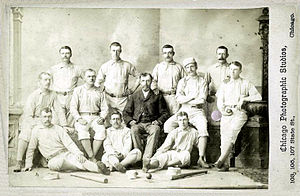
1882 Providence Grays
The Providence Grays were a Major League Baseball franchise based in Providence, Rhode Island from 1878 to 1885. During the team's eight seasons in the National League (NL), which then comprised eight teams, they finished third place or higher in the final standings seven times, and won the league championship in both 1879 and 1884. Providence played their home games at the Messer Street Grounds, which was located in the Olneyville neighborhood of Providence. The Grays were officially organized on January 16, 1878 by Benjamin Douglas, who became the team's general manager. Henry Root was hired as the team president‚ and Tom Carey was initially hired to be the on-field captain, whose duties were similar to the modern-day manager. On January 21, 1878, Providence applied for membership in the NL, and was officially approved on February 6. On April 10, Root took over ownership of the team, fired Douglas for incompetence and insubordination, and hired Tom York to replace Carey as captain.
Providence was successful in signing several star players for their inaugural season: Paul Hines had played the previous four seasons with the Chicago White Stockings; Tom Carey was signed after the Hartford Dark Blues folded; Doug Allison was the catcher for the 1869 Cincinnati Red Stockings, who had an 84-game winning streak from 1869 to 1870; and John Montgomery Ward, who was playing his first season in the major leagues. Ward had a win–loss record of 22–13 and Hines led the league in home runs, runs batted in (RBIs), and batting average as the Grays finished in third place among the six teams in the NL for the 1878 season, with a record of 33 wins, 27 losses, and 2 ties. The Grays won the NL championship in 1879, placing first among the league's eight teams with Ward winning 47 games as their starting pitcher, and the leadership of George Wright, who played second base and also managed. The team had a strong hitting line-up with Hines' league leading .357 batting average, as well as new additions Jim O'Rourke and Joe Start, who both had batting averages over .300. William Edward White, a Brown University player who played one game for the Grays on June 21, 1879, may have been the first African-American to play at the major league level; according to Peter Morris of the Society for American Baseball Research, the evidence for White is strong, but not conclusive. If this claim is true, then White pre-dated both Moses Fleetwood Walker and his brother Weldy Walker, who both played for the 1884 Toledo Blue Stockings of the American Association (AA). In 1880, the Grays finished in second place among the eight NL teams, with Ward winning 39 games. On June 17 of that year, Ward pitched the second perfect game in major league history. (Full article...) -
Image 3

Orlando Hernández won gold with the Cuban team in the 1992 Summer Olympics, baseball's first appearance as an Olympic medal sport.
Baseball is a sport formerly contested at the Summer Olympic Games. It was originally played as a demonstration sport in seven Olympics—1912, 1936, 1952, 1956, 1964, 1984, and 1988— more than for any other sport in Olympic history. These exhibitions featured a single game at the first five Olympic appearances and then a tournament format in 1984 and 1988. The International Olympic Committee (IOC) granted baseball official status on October 13, 1986, for the 1992 Summer Olympics. The sport was contested at each subsequent Games through 2008, after which the IOC removed it from the roster of Olympic sports.
In 1992, the first official Olympic baseball tournament was won by the Cuban team. Cuba had boycotted the 1984 and 1988 Olympics, missing the previous exhibition baseball tournaments, but entered in 1992 as the favorite, having won the past 12 world championships and with a 62–1 record in international competitions since 1986. The Cubans went undefeated in the 1992 Olympics and trailed in only one game. They went undefeated again at the 1996 Olympics en route to a second consecutive gold medal. The United States won their first medal (bronze) in the 1996 Olympics and then won gold at the 2000 Summer Olympics. 2000 was the first Olympics in which Cuba lost a game: first to the Dutch team in round-robin play and then again to the Americans in the gold medal game. This was also the first time professional players were allowed to compete in baseball, though Major League Baseball (MLB) did not permit any player on the 40-man roster of an MLB team to compete. In 2004, the reigning gold medalist United States did not qualify for the Olympic tournament, while the Cuban team won its third gold medal. (Full article...) -
Image 4
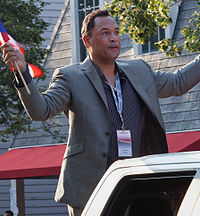
Roberto Alomar leads all second basemen with 10 Gold Glove Award wins.
The Gold Glove Award is the award given annually to the Major League Baseball players judged to have exhibited superior individual fielding performances at each fielding position in both the National League (NL) and the American League (AL), as voted by the managers and coaches in each league. Managers are not permitted to vote for their own players. Eighteen Gold Gloves are awarded each year (with the exception of 1957, 1985, 2007 and 2018), one at each of the nine positions in each league. In 1957, the baseball glove manufacturer Rawlings created the Gold Glove Award to commemorate the best fielding performance at each position. The award was created from a glove made from gold lamé-tanned leather and affixed to a walnut base. Initially, only one Gold Glove per position was awarded to the top fielder at each position in the entire league; however, separate awards were given for the National and American Leagues beginning in 1958.
Roberto Alomar leads second basemen in wins; he won 10 Gold Gloves in 11 years with three different American League teams. Ryne Sandberg has the second-highest total overall; his nine awards, all won with the Chicago Cubs, are the most by a National League player. Bill Mazeroski and Frank White are tied for the third-highest total, with eight wins. Mazeroski's were won with the Pittsburgh Pirates, and White won his with the Kansas City Royals. Joe Morgan and Bobby Richardson each won five Gold Glove Awards, and four-time winners include Craig Biggio (who won after converting to second base from catcher), Bret Boone, Bobby Grich, Orlando Hudson, Dustin Pedroia, and Brandon Phillips. Hall of Famers who won Gold Gloves at second base include Alomar, Sandberg, Mazeroski, Morgan, Biggio and Nellie Fox. (Full article...) -
Image 5
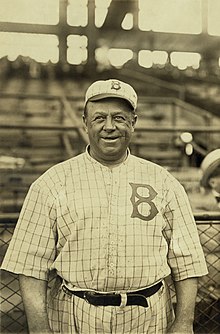
In baseball, a hit is credited to a batter when he reaches first base – or any subsequent base – safely after hitting a fair ball, without the benefit of an error or a fielder's choice. One hundred nineteen different players have recorded at least six hits in a single nine-inning Major League Baseball game. Five players have accomplished the feat more than once in their career; no player has ever recorded more than seven hits in a nine-inning game. Davy Force was the first player to collect six hits in a single game, doing so for the Philadelphia Athletics against the Chicago White Stockings on June 27, 1876.
These games have resulted in other single-game MLB records being set in connection with the prodigious offensive performance. Shawn Green, for example, established a new major league record with 19 total bases and finished with a total of five extra-base hits, tying a National League record that was also achieved by Larry Twitchell during the latter's six-hit game. Four of Green's six hits were home runs, equaling the record for most home runs in one game. Jim Bottomley, Walker Cooper, Anthony Rendon, and Wilbert Robinson hit 10 or more runs batted in (RBI) to complement their six hits. Robinson proceeded to collect a seventh hit and an eleventh RBI to set single-game records in both categories. Although his record of 11 RBIs has since been broken, Robinson's seven hits in a nine-inning game has been matched only by Rennie Stennett. (Full article...) -
Image 6
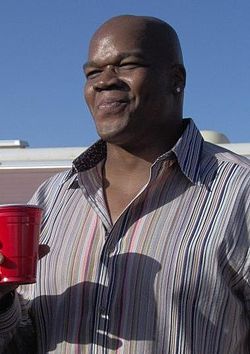
Frank Thomas (1989) was a two-time American League Most Valuable Player, and was a first-ballot Hall of Fame inductee in 2014.
The Chicago White Sox are a Major League Baseball (MLB) franchise based in Chicago, Illinois. They play in the American League Central division. Since the institution of MLB's Rule 4 Draft, the White Sox have selected 66 players in the first round. Officially known as the "First-Year Player Draft", the Rule 4 Draft is MLB's primary mechanism for assigning amateur baseball players from high schools, colleges, and other amateur baseball clubs to its teams. The draft order is determined based on the previous season's standings, with the team possessing the worst record receiving the first pick. In addition, teams which lost free agents in the previous off-season may be awarded compensatory or supplementary picks.
Of the 66 players picked in the first round by the Chicago White Sox, 32 have been pitchers, the most of any position; 20 of them were right-handed, while 12 were left-handed. Twelve outfielders, eight catchers, five shortstops, five third basemen, and four first basemen were also taken. The team has never drafted a player at second base. Fourteen of the players came from high schools or universities in the state of California, and Florida follows with eight players. The White Sox have also drafted six players from their home state of Illinois. (Full article...) -
Image 7

Roy Halladay, the Opening Day starting pitcher from 2003 to 2009
The Toronto Blue Jays are a Major League Baseball (MLB) team based in Toronto, Ontario. They play in the American League East division. The Blue Jays first played their home games at Exhibition Stadium until 1989, when they moved into the SkyDome, which was renamed Rogers Centre in 2005. The first game of the new baseball season for a team is played on Opening Day, and being named the Opening Day starter is an honour, which is often given to the player who is expected to lead the pitching staff that season, though there are various strategic reasons why a team's best pitcher might not start on Opening Day. The Blue Jays have used 25 different Opening Day starting pitchers in their 43 seasons. The 25 starters have a combined Opening Day record of 15 wins, 16 losses and 12 no decisions. No decisions are only awarded to the starting pitcher if the game is won or lost after the starting pitcher has left the game.
The Blue Jays first Opening Day starting pitcher was Bill Singer, who received a no decision against the Chicago White Sox. Roy Halladay holds the Blue Jays' record for most Opening Day starts with seven consecutively from 2003 to 2009, and has an Opening Day record of 3–3. Halladay also has the most starts at home with four. Dave Lemanczyk has the worst winning percentage as the Opening Day starting pitcher with a record of 0–2, both of which were pitched away from Exhibition Stadium. (Full article...) -
Image 8Lou Piniella won the 2008 National League Manager of the Year Award, and won twice in the American League.
In Major League Baseball, the Manager of the Year Award is an honor given annually since 1983 to two outstanding managers, one each in the American League (AL) and the National League (NL). The winner is voted on by 30 members of the Baseball Writers' Association of America (BBWAA). Each submits a vote for first, second, and third place among the managers of each league.[a] The manager with the highest score in each league wins the award.
Several managers have won the award in a season in which they led their team to 100 or more wins. They are:- Lou Piniella – 116 (Seattle Mariners, 2001)
- Joe Torre – 114 (New York Yankees, 1998)
- Gabe Kapler – 107 (San Francisco Giants, 2021)
- Sparky Anderson – 104 (Detroit Tigers, 1984)
- Tony La Russa – 104 (Oakland Athletics, 1988)
- Dusty Baker – 103 (San Francisco Giants, 1993)
- Larry Dierker – 102 (Houston Astros, 1998)
- Whitey Herzog – 101 (St. Louis Cardinals, 1985)
- Rocco Baldelli – 101 (Minnesota Twins, 2019)
- Buck Showalter – 101 (New York Mets, 2022)
- Brandon Hyde – 101 (Baltimore Orioles, 2023)
- Kevin Cash – 100 (Tampa Bay Rays, 2021)
-
Image 9
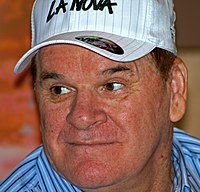
Pete Rose is the all-time MLB hits leader with 4,256 hits.
The 3,000-hit club is the group of 33 batters who have collected 3,000 or more regular-season hits in their careers in Major League Baseball (MLB). Reaching 3,000 hits has been "long considered the greatest measure of superior bat handling" and is often described as a guarantee of eventual entry into the Baseball Hall of Fame.
Cap Anson was the first MLB player to reach 3,000 hits, although his precise career hit total is unclear. Two players—Nap Lajoie and Honus Wagner—reached 3,000 hits during the 1914 season. Ty Cobb did so in 1921 and became the first player in MLB history to reach 4,000 hits in 1927, ultimately finishing his career with 4,191. Pete Rose, the current hit leader, became the second player to reach 4,000 hits on April 13, 1984, and surpassed Cobb in September 1985, finishing his career with 4,256. Roberto Clemente's career ended with precisely 3,000 hits, which he reached in the last at bat of his career on September 30, 1972. (Full article...) -
Image 10
Aaron Cook, the 2007 Opening Day starter
The Colorado Rockies are a Major League Baseball (MLB) franchise based in Denver, Colorado. They play in the National League West division. The first game of the new baseball season for a team is played on Opening Day, and being named the Opening Day starter is an honor, which is often given to the player who is expected to lead the pitching staff that season, though there are various strategic reasons why a team's best pitcher might not start on Opening Day. The Rockies have used 20 different Opening Day starting pitchers in their 28 seasons. Since the Rockies' first season in 1993, the 20 starters have a combined Opening Day record of eleven wins, nine losses (11–9), and eight no decisions. No decisions are only awarded to the starting pitcher if the game is won or lost after the starting pitcher has left the game.
Eight Rockies pitchers have started on two Opening Days: Kevin Ritz, Darryl Kile, Mike Hampton, Jason Jennings, Aaron Cook, Ubaldo Jiménez, Jorge de la Rosa, and Jon Gray. Kile has the best Opening Day record with two wins and no losses. Armando Reynoso is the only Rockies pitcher to start on Opening Day in Colorado's former home of Mile High Stadium. Rockies starting pitchers have an Opening Day record of four wins, two losses, and one no decision when at home. With the exception of one lost game at Mile High Stadium, the other games were played at Colorado's current home stadium of Coors Field. On the road for Opening Day, Colorado starting pitchers have accumulated a record of seven wins, seven losses, and seven no decisions. The Rockies have a record of two wins and three losses on Opening Day for seasons in which they would later go on to participate in post-season play. (Full article...) -
Image 11A bronze statue of Luis Aparicio, the namesake of the award
The Luis Aparicio Award is given annually to a Venezuelan player in Major League Baseball (MLB) who is judged to have recorded the best individual performance in that year. The winner of the award is determined by a vote conducted by Venezuelan sports journalists and Spanish-language media around the world. It is named after former MLB shortstop Luis Aparicio, who is the only player from Venezuela to be inducted into the National Baseball Hall of Fame. The award was first presented in 2004, and was created in order to honour Aparicio's major league career and to commemorate his father, who died thirteen years before his son was elected into the Hall of Fame.
Johan Santana, Jose Altuve, Miguel Cabrera, and Ronald Acuña Jr. are the only players to win the Luis Aparicio Award more than once, with Cabrera having won the award five times. Cabrera won the MLB Most Valuable Player (MVP) Award and Hank Aaron Award alongside the Luis Aparicio Award in 2012 and 2013, becoming the first Venezuelan to win the MLB MVP Award. Santana, the 2004 and 2006 recipient, also won the Cy Young Award in those two years, winning by a unanimous vote on each occasion. Altuve is the only player to win the Luis Aparicio Award, the MVP award, and become a World Series champion in the same season in 2017. He has also won a batting title in three of his four award seasons. Santana (2006) and Cabrera (2012) are the only award winners to also earn the pitching and batting Triple Crown respectively in the same season. In accomplishing the feat, Cabrera became the first player in 45 years to achieve a Triple Crown in batting since Carl Yastrzemski in 1967, while Santana became the first pitcher since Dwight Gooden in 1985 to secure a "Major League Triple Crown" by leading all of MLB in wins, earned run average and strikeouts. Francisco Rodríguez compiled a major league record of 62 saves in a single season in 2008 and went on to win the Rolaids Relief Man Award in the same year as the Luis Aparicio Award. Five winners – Cabrera, Altuve, Magglio Ordóñez, Carlos González, and Arráez – were batting champions in their respective leagues in the same year they won the award. (Full article...) -
Image 12The Major League Baseball Comeback Player of the Year Award is presented by Major League Baseball (MLB) to the player who is judged to have "re-emerged on the baseball field during a given season." The award was developed in 2005, as part of a sponsorship agreement between MLB and Viagra. In 2005 and 2006 representatives from MLB and MLB.com selected six candidates each from the American (AL) and National Leagues (NL) and one winner for each league was selected via an online poll on MLB.com. Since then, the winners have been selected by a panel of MLB beat reporters. Under the current voting structure, first place votes are worth five points, second place votes worth three, and third place votes worth one with the award going to the player with the most points overall. Past winners have often overcome injury or personal problems en route to their award-winning season.
A Comeback Player of the Year Award has been given by The Sporting News since 1965 but its results are not officially recognized by Major League Baseball. Since the beginning of the MLB award in 2005, the recipients have been identical with the following exceptions: 2008 NL (TSN honored Fernando Tatís, MLB honored Brad Lidge), 2010 AL (TSN honored Vladimir Guerrero, MLB honored Francisco Liriano), 2012 AL (TSN honored Adam Dunn, MLB honored Fernando Rodney), 2016 (TSN honored Jose Fernandez and Mark Trumbo, MLB honored Anthony Rendon and Rick Porcello), 2018 NL (TSN honored Matt Kemp, MLB honored Jonny Venters), 2019 AL (TSN honored Hunter Pence, MLB honored Carlos Carrasco), and 2020 AL (TSN honored Carrasco, MLB honored Salvador Pérez). Liriano and Posey are the only players to win the MLB award multiple times with Liriano being the first to win it in each league. (Full article...) -
Image 13
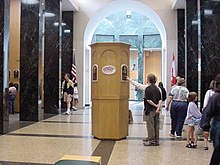
The plaque gallery at the Baseball Hall of Fame
The National Baseball Hall of Fame and Museum in Cooperstown, New York, honors individuals who have excelled in playing, managing, and serving the sport, and is the central point for the study of the history of baseball in the United States and beyond, displaying baseball-related artifacts and exhibits. Elections of worthy individuals to be honored by induction into the Hall of Fame commenced in 1936, although the first induction ceremonies were not held until the hall opened in 1939. Through the elections for 2024, a total of 346 people will have been inducted, including 274 former professional players, 39 executives/pioneers, 23 managers, and 10 umpires. Each is listed showing his primary position; that is, the position or role in which the player made his greatest contribution to baseball according to the Hall of Fame.
According to the current rules, players must have at least 10 years of major league experience to be eligible for induction. In addition, they must be retired for at least five years if living, or deceased for at least six months. Players meeting these qualifications must pass through a screening committee, and are then voted on by the Baseball Writers' Association of America (BBWAA). Each writer may vote for up to 10 players; to be admitted into the Hall of Fame, a player must be approved by 75% of those casting ballots. Players receiving less than 5% approval are removed from future BBWAA ballots. The rules, as revised in July 2016, allow that all individuals eligible for induction but not for the BBWAA ballot—players who have not been approved by the BBWAA election process within 15 years of their retirement, umpires, managers, pioneers, and executives—may be considered by one of four voting bodies that have taken over the role of the former Veterans Committee, based on the era in which each individual candidate made his greatest contribution to the sport. On a few occasions, exceptions have been made to the guidelines in place at the time: Lou Gehrig was elected in 1939 following his diagnosis of amyotrophic lateral sclerosis; Roberto Clemente was elected shortly after his death in 1972; and Addie Joss was elected in 1978 even though he completed only nine seasons before his death. (Full article...) -
Image 14The Chicago Cubs are a professional baseball team based in Chicago, Illinois. The Cubs are members of the National League (NL) Central Division in Major League Baseball (MLB). In baseball, the head coach of a team is called the manager, or more formally, the field manager. The duties of the team manager include team strategy and leadership on and off the field. Since their inception as the White Stockings in 1876, the Cubs have employed 61 managers. The franchise's first manager was Baseball Hall of Famer Albert Spalding, who helped the White Stockings become the first champions of the newly formed National League.
After co-managing with Silver Flint during the 1879 Chicago White Stockings season, Hall of Famer Cap Anson began an 18-year managerial tenure in 1880, the longest in franchise history. Under Anson, the team won five more NL pennants — in 1880, 1881, 1882, 1885 and 1886—tying the 1885 World Series and losing the 1886 World Series in the process.[a] Anson won 1,283 games as the White Stockings' manager, the most in franchise history. After taking over for Hall of Fame manager Frank Selee in 1905, Frank Chance — another Hall of Famer — managed the team through the 1912 season. During his tenure, the franchise won four more NL pennants in 1906, 1907, 1908, and 1910, winning its only two World Series titles in 1907 and 1908 until 2016 Chance's .664 career winning percentage is the highest of any Cubs manager. After Chance, from 1913 through 1960, the Cubs employed nineteen managers, nine of which were inducted into the Hall of Fame. During this period, the Cubs won six more NL pennants, including three under manager Charlie Grimm. Split between Grimm's two managerial stints in the 1930s and 1940s, plus a brief appearance as manager in 1960, Grimm accumulated 946 career wins, second-most in franchise history behind Anson. (Full article...) -
Image 15

Hard Rock Stadium, the Marlins former home ballpark from 1993-2011
The Miami Marlins are a Major League Baseball (MLB) franchise based in Miami, Florida. They play in the National League East division. The first game of the new baseball season for a team is played on Opening Day, and being named the Opening Day starter is an honor, which is often given to the player who is expected to lead the pitching staff that season, though there are various strategic reasons why a team's best pitcher might not start on Opening Day. The Marlins have used 17 different Opening Day starting pitchers in their 27 seasons. Since the Marlins' first season in 1993, the 17 starters have a combined Opening Day record of 12 wins and 14 losses with two no-decisions. Notably, no Marlins Opening Day starter received a no-decision until the team's 24th season in 2016. No-decisions are only awarded to the starting pitcher if the game is won or lost after the starting pitcher has left the game.
Nine Marlins pitchers have started on two or more Opening Days. Those nine are Charlie Hough, Kevin Brown, Alex Fernandez, Ryan Dempster, Josh Beckett, Dontrelle Willis, Josh Johnson, Ricky Nolasco, and José Ureña. Beckett and Johnson hold the record for most Opening Day starts as a Marlin, with three appearances each, from 2003 to 2005 for Beckett and 2010 to 2012 for Johnson. When playing at their original home field, the venue now known as Hard Rock Stadium, the Marlins had a record of nine wins and five losses (9–5). At their current home of Marlins Park, Opening Day pitchers have a record of 1–5 with one no-decision. In the franchise's history, the Marlins have only played Opening Day games at another team's home stadium eight times. As the away team, Marlins' starting pitchers have an Opening Day record of 1–6 with one no-decision. (Full article...)
More did you know
- ... that despite its author keeping detailed journals of his experiences, the baseball memoir Odd Man Out was criticized by many people named in the book as being factually inaccurate?
- ... that the longest extra inning game in professional baseball history was an International League game that lasted 33 innings?
- ... that two members of the $100,000 infield have been inducted into the Baseball Hall of Fame?
- ... that three of the four batters faced by Mike Palagyi in his one Major League game were later inducted into the Baseball Hall of Fame?
- ... that Boston Red Sox third baseman Will Middlebrooks is engaged to a former Dallas Cowboys cheerleader whom he has known since childhood?
Sports portals
Selected picture

| Credit: Keith Allison |
Mariano Rivera (born November 29, 1969) is a Panamanian professional baseball player who has spent his entire Major League Baseball (MLB) career with the New York Yankees. Nicknamed "Mo", the right-handed Rivera has served as a relief pitcher for most of his career. His presence in the late innings of games to record the final outs has played an instrumental role in the Yankees' success, particularly the team's late 1990s dynasty, which won four World Series championships.
Associated Wikimedia
The following Wikimedia Foundation sister projects provide more on this subject:
-
Commons
Free media repository -
Wikibooks
Free textbooks and manuals -
Wikidata
Free knowledge base -
Wikinews
Free-content news -
Wikiquote
Collection of quotations -
Wikisource
Free-content library -
Wikiversity
Free learning tools -
Wiktionary
Dictionary and thesaurus
More portals
- Portals with triaged subpages from June 2018
- All portals with triaged subpages
- Portals with no named maintainer
- Automated article-slideshow portals with 51–100 articles in article list
- Automated article-slideshow portals with 501–1000 articles in article list
- Random portal component with 41–50 available subpages
- Automated article-slideshow portals with 201–500 articles in article list
- Random portal component with 11–15 available subpages
- Random portal component with 21–25 available image subpages






